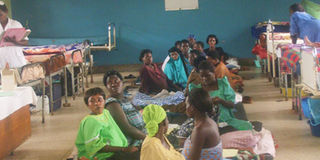Hospital staff shortages, lack of equipment causing the highest number of stillbirths

Expectant mothers sitting on the floor in a labour ward as they await medical attention. Such scenes, with too many patients, too few staff and not even enough beds to accommodate all of them, are synonymous with many hospitals.
On May 5, while marking International Midwifery Day, Dr Babatunde Osotimehin, Executive Director of the United Nations Population Fund said, “Every day, 1,000 women die and 5,500 newborns die in the first week of life for lack of adequate medical care”.
Dr Michael Oscinde, director of Jinja referral hospital, illustrates that while ideally, all mothers in labour should be monitored by a pantograph–a standard tool developed by World Health Organisation, for serious decision making. When using the pantograph, it is mandatory that one mother is monitored by one midwife at a time but the doctor notes, “In our hospitals where human resource is low, labour management is risky. Jinja hospital on average performs between 20 and 30 deliveries a day.”
He further explains, “It takes about 10 hours monitoring a mother in labour, meaning that while using the pantograph, in two hours you need 30 midwives for 30 deliveries. Consider Mulago, which on an average day carries out 50 to 120 deliveries. It is incomprehensible. No midwife should monitor two mothers at a go. It is prone to inefficiency, high risk and mistakes yet that is what happens,” he explains.
According to figures at the Jinja referral hospital, in the month of May, 508 mothers gave birth. Of these, 401 were by vaginal delivery while 107 deliveries by Caesarean section; the latter accounting for 20 per cent. Six children out of those born by C-section died while there were two neonatal deaths of the 401. Five mothers lost their lives.
Also, preferably, midwives are needed at many stages before, during and after delivery in family planning clinics, maternity wards, post natal units and even monitoring mothers after six weeks of delivery.
Dr Oscinde says, “We don’t have that luxury in this country. Most districts don’t have a single midwife. It is recommended that there is at least a midwife to as small as a health centre II. Until the human resource component is addressed, we still operate at high risk.”
There is a general shortage of medics country wide especially in government hospitals, which has repeatedly been blamed on poor remuneration.
The few available are overwhelmed by the work load amidst no or insufficient equipment. “It is a puzzle but blaming someone for neglect should come after all avenues have been exhausted,” reasons the obstetrician.
Other possible causes of stillbirths
Otherwise, medics say that very rarely, stillbirths can occur unexpectedly in healthy pregnancies, but there are also several known risk factors, including: multiple pregnancies, smoking during pregnancy, pre-existing health problems, such as high blood pressure or diabetes, eclampsia in the mother, to mention but a few.
Oscinde adds that some women use herbs thereby putting the baby and themselves at risk of getting poisoned. “Not even those administering the concoction are sure of the dosage,” he says.
These herbs are one of the reasons that some children are born with depressed brains that result into long life debilitations.




